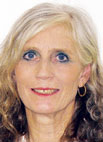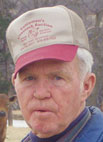 Randall Davis, ranch manager for Honey Creek Land and Cattle, stands next to a converted stock trailer that could be likened to a truck modified for rock climbing.
Randall Davis, ranch manager for Honey Creek Land and Cattle, stands next to a converted stock trailer that could be likened to a truck modified for rock climbing.
A modification to navigate the rough and rocky terrain of the deceptively beautiful hills and hollows just over the Missouri state line into Arkansas. The 1,500-acre ranch traverses into Arkansas, Missouri and Oklahoma, a place where cell service and Internet are the only intrusions of the modern world.
As his grey cow horse shifts anxiously in the trailer prepared for a days work, Randall discusses his philosophy on herd management and the tools he employs to develop lasting buyer relationships through tried and true networking with a little help from social media and the Internet. The notion that modern technology and traditional methods of managing cattle is an oxymoron in today’s world of fiber optics, YouTube and video conferences are quickly disproven as Randall manages the ranch using the best of both worlds.
Originally from Southeast Oklahoma, Randall grew up around horses and cattle; in fact, he also trains cow horses and sometimes participates in the popular Mustang Makeover competitions. His wife, Wylene Wilson-Davis, shares his love of horses. She is a professional horsemanship clinician, with a business that has grown with her many successes, including being a two-time winner of the Supreme Extreme Mustang Makeover, which promotes wild BLM Mustang adoptions through individual mustang makeovers.
He admits he has developed a love for the area with its green valleys and rolling hills. He originally relocated to help his good friend, J.W. Brooks, build custom cowboy hats when he happened upon the Honey Creek management position.
He prefers the horse over ATVs due to their responsiveness to the unpredictable nature of the cows and the land where they graze, not to mention the cows are generally calmer with a horse then a motorized vehicle.
“If you do it properly, you can get up to a calf, tag ’em, note who the mother is and its sex while the cow stands nearby,” Randall said.
The lay of the land naturally allows for segregation of cows and calves in different stages of production throughout the grassy hollows and pastures. Much of the operation involves anywhere from 150 to 300 bred heifers at a time, with about 200 feeder calves. They have developed a breeding schedule that allows for a set of 100 to 150 spring calves and more in the fall.
While this method is reminiscent of cattle drives and John Wayne movies, Randall combines the old – fashioned methods of working cattle with modern methods of herd management. Using ultrasound equipment owned by the ranch, he is able to use those tools with the Honey Creek herd and assist other ranches.
Ranch owner, Dan Dykema, is proactive about his cattle business and stays on top of the market trends, while Randall markets the cows through Internet sources or through various cattle producer groups on Facebook.
“We like to sell 50 to 100 head at once to one person,” Randall added.
Part of the ranch’s marketing strategy relies on the large contact base that Randall has developed. He stresses that networking is key and while word of mouth is free, it also builds trusting relationships based on the quality of the cows and the honesty that Randall conveys to the individual buyers.
Because Randall checks the herd four times a day and sometimes twice at night, depending whether it is calving season or not, he documents every contact with every cow in a notebook that he later transfers to a spreadsheet. The data is further developed as a marketing tool for the benefit of the buyer.
“We make sure we have a lot of data on these cattle, so we know exactly what goes into them but also so we can represent them accurately to the buyer,” Randall said.
Randall contends that success in cattle is much like success in any business.
“I always put myself in the buyer’s shoes when I look at our herd,” he added. “I want the buyer to be happy and I want the cattle to produce for them.”







